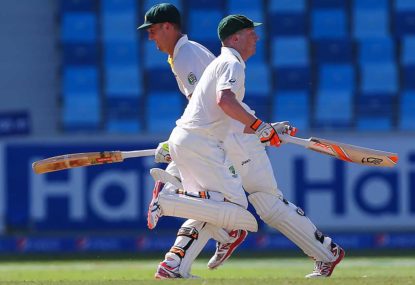Chris White
new author
Roar Rookie

Looking at the Australian Test team, it’s hard to see anything being wrong.
Steve Smith and David Warner are scoring tons for fun, and other players chipping in runs as well – three times in three Tests we’ve scored more than 500 runs in an innings, and we’re on track to do it again in Sydney.
The bowlers have taken 20 wickets in each of the Tests, India look bereft of confidence, and we’re currently second in the rankings for the ICC Test Championship.
>> Australia vs India Day 2 live scores
Yet something is wrong.
Let’s start at the top.
After his 95 on Tuesday, Chris Rogers has scored five half-centuries in as many innings. Which is fantastic, but Rogers only seems to score runs once the media questions his ability to do so. Most people seem to have forgotten that he had the same problem against Pakistan in the UAE, against South Africa last year, and against England.
After failing in the first Test against India, the media began to question whether Rogers deserved his baggy green (again). Cue his current run of half tons. His decision to retire from international cricket after the Ashes may well lead to him playing well in England – but it may not, as once he regains confidence in his batting the runs seem to dry up, and out come scores in the 30s and lower.
The problem I have with Rogers that he’s 37 and a player of his age is right to be considering his retirement. But the axe should have swung earlier.
So, Rogers gets out, and who is in next? Australia’s first drop is another player who faces the axe. In his entire Test career (which spans 10 years now) Shane Watson has only 4 hundreds to his name, and 24 half tons. He also has 71 wickets, which people tend to point to in order to justify his spot in the team, which would make more sense if he were batting in a traditional all-rounder’s spot, around six or seven.
This series, however, Watto has only taken two wickets, for 164 runs. By contrast, Peter Siddle, who is three years his junior and has only played one Test match this series, took two wickets for 109. Siddle didn’t get a chance to bat, but Watson managed 47 runs over two innings. Watson is almost 34. Surely it’s time to declare.
There are other surprisingly old players in the Test side. Shaun Marsh, who’s only played 11 Test matches, doesn’t come across as an old player – he’s only just got into the team, right? SE Marsh is 31 years old. Brad Haddin, our wicketkeeper, is 37. Michael Clarke is 33, as is Mitchell Johnson. Ryan Harris is 35. Siddle was actually the youngest member of Australia’s pace battery – which is not to say that he deserves his spot over Johnson. Even players outside of the Test squad who are considered up-and-comers are surprisingly old – Usman Khawaja, for instance, is already 28.
With the series over after the draw in Melbourne, Australia should have considered its ageing stable of Test cricketers (the average age of the Test team is just under 30). Sydney is a dead rubber, and with Smith filling the role of captain rather nicely in Brisbane (less so in Melbourne), maybe the time was right to test new players, to give the young guns a chance and some exposure against an India side that has been poor.
There are three players who should definitely be dropped from the Australian side – Chris Rogers, Brad Haddin, and Shane Watson. Clarke, Shaun Marsh, Harris and Johnson are also on their way out of the side; Harris and Johnson due to age, Marsh because of unconvincing form, and Clarke because of near-permanent injury. But who would fill their places?
If we’re considering like-for-like changes, then Chris Lynn, Mitchell Marsh (yes, I know he’s injured), and Glenn Maxwell are surely pushing for a batting place, with the added bonus of Marsh taking the all-rounder position. Either Matthew Wade or Ben Dunk need to be in the Test team as soon as possible – wicketkeepers tend to need time to settle, and both are already in their late 20s.
Our pace bowling stocks are in a particularly good way. Mitchell Starc, Pat Cummins, Sean Abbott, and James Pattinson have all the makings of a brilliant pace battery.
The future of Australian Test cricket looks bright, but we need to face the facts that our team is ageing, and the final Test of an already-won series would have been the perfect time to give the kids a chance.